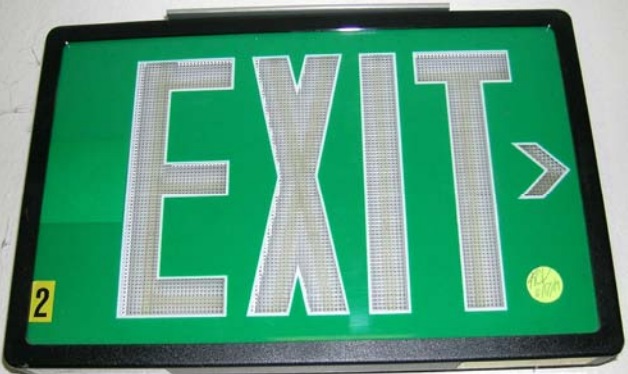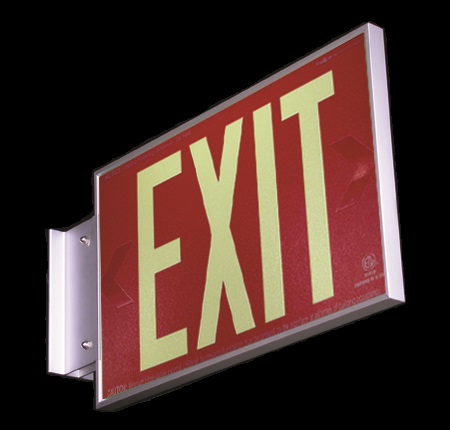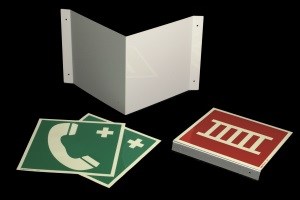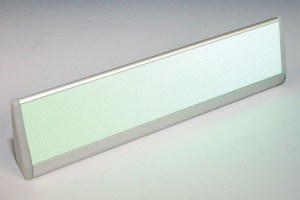Avoid Risk
- Radioluminescent exit signs contain a radioactive and toxic component- tritium
- The use of tritium exit signs is prohibited by the US Department of Defense, the city of Berkeley, CA, and numerous college campuses
- Tritium exit signs last for only 10, 15 or 20 years; until the radioactive tritium is exhausted
- Tritium is monitored and controlled by the NRC- Nuclear Regulatory Commission
- Failure to comply with NRC requirements regarding the use and disposal of tritium exit signs may result in severe penalties
- Tritium, escaping from broken or damaged exit signs, will contaminate your facility and could result in huge liability or safety issues
- Clean-up of tritium is an enormously costly and complicated process
Can you afford to close your facility for days of clean-up & inspection?
Can you afford clean-up costs of more than $100K per occurrence?
Can you afford the cost of lawsuits and other legal actions?
Contact EverGlow
Toll Free: (1) 866-744-4706
Telephone: (1) 704-841-2580
Email Us: This email address is being protected from spambots. You need JavaScript enabled to view it.

Tritium Exit Signs use a radioactive isotope of hydrogen to illuminate the phosphors of the sign face.
Avoid Radiation Hazards & Disposal Costs
It can cost $50-$150 to properly dispose of expired tritium exit signs!!!!
- Replace tritium exit signs with safe, non-toxic photoluminescent exit signs from EverGlow
- EverGlow photoluminescent exit signs are warranted for 25 years (interior installations, 3 years for exterior installations) and should last as long as your facility
- EverGlow exit signs (sign faces, frames, mounting brackets) are aluminum and easily recycled at no cost or inconvenience
- Photoluminescent exit signs are the only code compliant, non-electrical and non-toxic solution
- EverGlow photoluminescent exit signs consume ZERO energy
- EverGlow photoluminescent exit signs are completely green - containing ZERO radioactive, toxic or vinyl components
- EverGlow photoluminescent exit signs contain a minimum of 60% post-consumer recycled content
- Compare safe, reliable & effective EverGlow photoluminescent exit signs
What Is Tritium & Why Are Radioactive Tritium Exit Signs a Liability?
Tritium is the only radioactive isotope of hydrogen. (An isotope is a different form of an element that has the same number of protons in the nucleus but a different number of neutrons.) The nucleus of a tritium atom consists of a proton and two neutrons. This contrasts with the nucleus of an ordinary hydrogen atom (which consists solely of a proton) and a deuterium atom (which consists of one proton and one neutron). Ordinary hydrogen comprises over 99.9% of all naturally occurring hydrogen. Deuterium comprises about 0.02%, and tritium comprises about a billionth of a billionth (10-16 percent) of natural hydrogen.
Radioactive tritium decays with a half-life of 12 years by emitting a beta particle to produce helium-3. Tritium is generated by both natural and artificial processes- by solar radiation in the atmosphere, in nuclear reactors and as a fission product from nuclear weapon detonations. The US Department of Energy (DOE) monitors the production and use of tritium.
Tritium is used in fission and thermonuclear (nuclear) weapons to increase the yield (explosive force). Exports of tritium are controlled by agencies of the US government to prevent rogue states and terrorists from collecting enough material to aid the development and proliferation of nuclear weapons.
Recently, owners and managers of facilities that have tritium exit signs have had to account for the signs they currently have and those signs that have been removed from service. It appears that large numbers of these signs have been disposed of improperly and there is the possibility that the government will impose severe penalties.
- In the environment, tritium can replace hydrogen in water and many other compounds common in living tissue- people, animals & plants
- Tritium is tasteless and odorless; it is undetectable in the environment without a radiation counter
- Radioactive tritium has moved into the food we eat and the water we drink
- Tritium is produced by nuclear reactors and weapons
- Tritium is a key component used to increase the yield of nuclear weapons
- Tritium is not a chemical that most managers want to have in their facilities
What Danger Does Radioactive Tritium Pose to the Health of Children & Adults?
Generally, tritium in radioluminescent exit signs is not dangerous. The low energy beta particles from tritium decay are absorbed by only 6 millimeters of air or 6 micrometers of tissue. Tritium poses a health hazard only if it is taken into the body, because tritium decays by emitting a low-energy beta particle. There is no high energy gamma radiation emitted in this decay. The most likely form of uptake is as tritium oxide (or tritiated water), as the inhalation of tritium gas is typically very low. If the glass vials in a tritium exit sign, which contain the tritium gas are broken because of abuse or demolition, tritium gas can be inhaled in significant quantities and the tissue in our lungs allows radioactive tritium to be absorbed directly into the bloodstream and move quickly around our body.
Tritiated water behaves the same as ordinary water, both in the environment and in the human body. Hence, a significant fraction of the inhaled and ingested tritium is directly absorbed into the bloodstream. The health hazard of tritium is associated with cell damage caused by the ionizing radiation that results from radioactive decay, with the potential for subsequent cancer induction.
Regardless of how radioactive tritium is taken into the body, it is uniformly distributed through all biological fluids within one to two hours. Most tritium is eliminated from the body within about 10 days, the same as for clean drinking water. During the time it is in the body, a small fraction of the tritium is incorporated into easily exchanged hydrogen sites in organic molecules.
Protect Yourself & Your Staff from Broken Radioactive Tritium Exit Signs
The US Environmental Protection Agency recommends the following actions. Some basic precautions can minimize the risks of broken or damaged tritium exit signs. The tritium in exit signs can be identified by the tube (sealed source) that contains tritium. In an exit sign, the tubes are used to spell out the word EXIT.
Never tamper with a tritium exit sign.
A tritium exit sign should be clearly labeled with a statement that it contains tritium. Return outdated tritium exit signs to the manufacturer. The address of the manufacturer usually can be found on the back of the tritium exit sign. The manufacturer can provide instructions on how to ship the tritium exit sign safely. Disposal of the broken sign should be arranged through the manufacturer or a health physics consultant. When an exit sign containing tritium is damaged and the sealed tube within the sign is broken, you should:
- Leave the sign alone; do not touch it.
- Evacuate the area immediately.
- Isolate the area; do not allow entry.
- Ventilate the area to the outside.
- Identify all individuals possibly exposed.
If you think you have been contaminated, you should:
- Shower with soap and water (or at least wash face and hands).
- Change clothing and put the potentially contaminated clothes in a plastic bag for testing to confirm exposure.
- Drink plenty of fluids to help the tritium leave the body more quickly.
- Collect a urine sample for testing to confirm or rule out internal exposure.
- Call your local fire or police departments.
- Call your state's radiation control program.
- Call the manufacturer for technical information.
Look Who is Protecting You!
EPA - US Environmental Protection Agency
Under the Clean Air Act, EPA establishes regulatory requirements for hazardous air pollutants including tritium air releases. Under the Safe Water Drinking Act, EPA sets limits for acceptable levels of tritium in drinking water. EPA also responds to emergencies involving tritium releases to the environment. In addition, before being approved for public use, sites previously contaminated with tritium must meet EPA's risk-based criteria for soil and ground water.
DOL - US Department of Labor
OHSA - Occupational Safety and Health Administration issues regulations and standards for the safety of workers in a wide range of occupational settings including construction and demolition.
NRC - US Nuclear Regulatory Commission
The primary mission of NRC is to protect public health and safety and the environment from the effects of radiation from nuclear reactors, sealed sources containing radioactive materials, and radioactive waste facilities.
Individual State Governments & Agencies
Each state has one or more programs to address radiation protection issues and respond to and investigate incidents involving tritium. Thirty-four states have signed formal agreements with NRC, providing the states regulatory responsibility over small quantities of special nuclear material and its source and byproducts. These states are known as NRC-Agreement States.
Tritium Exit Signs in the News
Teen takes apart sign at home, Jill Lipoti, New Jersey Department of Environment - An incident in New Jersey demonstrates the consequences of improper management of a tritium sign. In New Jersey we had an incident where a 16 year old boy picked up a discarded tritium exit sign, took it back to his room and took it apart with a screwdriver while he was eating sunflower seeds. He ingested the tritium because when you break the vials, it releases tritium into the air. The tritium will glom on to anything that moisture will be attracted to, so he ingested tritium. The child managed to call the poison control center and get us involved right away. But his room had to be decontaminated, he had to be decontaminated, his family had to be put up at a hotel while all of this was going on. The cost to the state, which was paid for by the New Jersey spill fund, was over $100,000 and interestingly the child, the 16 year old, through drinking lots of fluids, was able to keep his dose to about 80 mrem. But still imagine this, this one exit sign, and one kid and he managed to contaminate himself and his house.
Elizabeth Cotsworth, Director, Office of Radiation and Indoor Air, U.S. Environmental Protection Agency - Product stewardship is a concept that applies to many materials where we have concerns about the possibility that they could get into the environment and cause problems in the environment and to human health if they were, people were exposed to them. And tritium exit signs are one of those items that we would like, through partnership with industry, with states, to make sure that they are managed properly and effectively. That when they come to the end of their useful life that they are returned to the manufacturer for either recycling or safe disposal.
Label alerts resale-store workers to close call, Cheryl Rogers, Radiation Protection Section, Wisconsin Department of Health and Family Services - Sometimes the States or Federal agencies get a call requesting assistance before the situation has resulted in an expensive clean-up. There was an instance where a tritium sign ended up at one of those used clothing type places and they were actually trying to take it apart because they wanted to save the good metal or whatever. And then the person got nervous I guess cause there is a little label on the sign. So he did see the little label and again called the NRC. Tried to call anonymously but it was kind of obvious who it was when we showed up at the store. And anyway that one had a happy ending too because the tube containing the tritium wasn't broken. But that's the main problem, sometimes people try to take them apart and that can cause problems if you break the tube with the tritium in it.
Joe Klinger, Illinois Department of Nuclear Safety - A residential garage was contaminated by tritium. Although contamination was largely confined to a non-residence, the clean-up process ... was expensive and extensive. The garage was full of items and there was contamination everywhere. Since no one was living there, the Nuclear Safety agents let the garage air out for a period of time to let the tritium dissipate over time through ventilation. Later the IDNS staff took the items in the garage and either decontaminated or packaged them for disposal as radioactive waste. The final dose estimates were 7.1 mrem for the man, 1.07 mrem for his wife, and 1.06 mrem for his daughter. The cost of the clean-up was $64,000. The company that owned the exit sign agreed to pay for the clean-up.
Scrap metal yard calls authorities, controls contamination, Cheryl Rogers, Radiation Protection Section, Wisconsin Department of Health and Family Services - An incident investigated in Wisconsin provides evidence that tritium EXIT signs are not always disposed of properly. We had a phone call to us from a recycling center and actually they were referred to us by the NRC. And they were very good about calling and telling us that they had found this. And actually in this instance, we were able to trace it back to where it came from, which is kind of lucky. But they called us right away and we went over there and bagged the signs up and took some wipes to see if there was contamination because I believe some of the signs were broken. And did find that we had a little bit of contamination but it was contained in the barrel that the device was in. And eventually the originator, where the signs came from, stepped up and actually helped pay to have the signs shipped back to the manufacturer, so that story had a happy ending. But they did the right thing, they called us.
Youth smashes sign in hospital dorm, Jill Lipoti, New Jersey Department of Environment - This incident in New Jersey illustrates the potential clean-up costs and liabilities that can result from a sign being broken indoors. We had another incident that occurred in New Jersey. It was at the Arthur C. Brisbane treatment center for disturbed children. It happened just a few days before Halloween, the kids were rambunctious, and one of the kids grabbed the exit sign off the wall, threw it down on the ground, threw another kid on top, and the vials of tritium were breached and the tritium was released. The children were evacuated from their cottage and we commenced the cleanup that cost over $200,000. The dose to the children was kept very low because we took actions right away and the highest individual was exposed at less than 20 milirem. We had of course the other incident as guidance for us to be able to keep their doses low.
Renelle Rae, Senior Advisor, Office of Radiation and Indoor Air, U.S. Environmental Protection Agency - Tritium exit signs are considered a low level hazard for radiation and this sometimes leads to people being careless about how they're handled. And particularly how they're transferred to other people. And the irony of this is that it's only when they're used improperly and they break and the material is spread all over the place that there's a huge clean-up cost that can be very high and be disproportionate to what is really a low hazard when used properly.
Dr. Jill Lipoti, Director, Division of Environmental Safety and Health, New Jersey Department of Environmental Protection - Tritium exit signs are very useful. They can illuminate the pathway out of a burning building and you can save lives. So I don't think we want to eliminate the tritium exit sign. But tritium exit signs are very tightly regulated where they're manufactured, then they're left in place for years and years and people forget they're even there and that they were radioactive to begin with. And then they dispose of them improperly. There's something wrong with the regulatory system that regulates very tightly at the manufacturer, that tries to regulate later after it's been disposed of improperly, but that allows these signs to be left in place and just forgotten about for years and years. We need to improve that; we need to be able to have people keep track of their exit signs during the whole useful life of that exit sign.
Resources & Links to Learn More about Radioactive Tritium Exit Signs
Radioactive Tritium Exit Signs - Fact Sheet Provided by Los Alamos National Laboratory.
RadTown USA - US Environmental Protection Agency - Discarded Tritium Exit Signs.
HPS - Health Physics Society - Proper Clean-Up for Broken Tritium Exit Signs
Our job is to protect public health and the environment. And this training program, developed in an easy to use, very accessible format for the many people who might be in the handling chain of these tritium exit signs, is a very important step for us in terms of protecting human health and the environment from exposure to radioactive sources.
Elizabeth Cotsworth, Director, Office of Radiation and Indoor Air, U.S. Environmental Protection Agency
Tufts University - Tritium Exit Signs are NOT Allowed to be Installed on Campus.
TreeHugger.com - Tales of Vanishing Tritium Exit Signs Prompt Health Concerns.
... results confirm the existence of measurable concentrations of tritium in landfill leachate effluents and prompted BRP to recommend further monitoring of landfill leachates for possible impact on drinking water supplies. While it is not feasible or practical to confirm the exact sources of the observed tritium in leachate, the Commonwealth believes that gaseous tritium light source (GTLS) EXIT signs have been, and continue to be, disposed in landfills. These GTLS devices contain significant quantities of tritium gas that, once ruptured in a landfill, are readily oxidized into tritiated water that is eventually captured as leachate.
Pennsylvania Environmental Protection - Owner Responsibility for Tritium Exit Signs.






